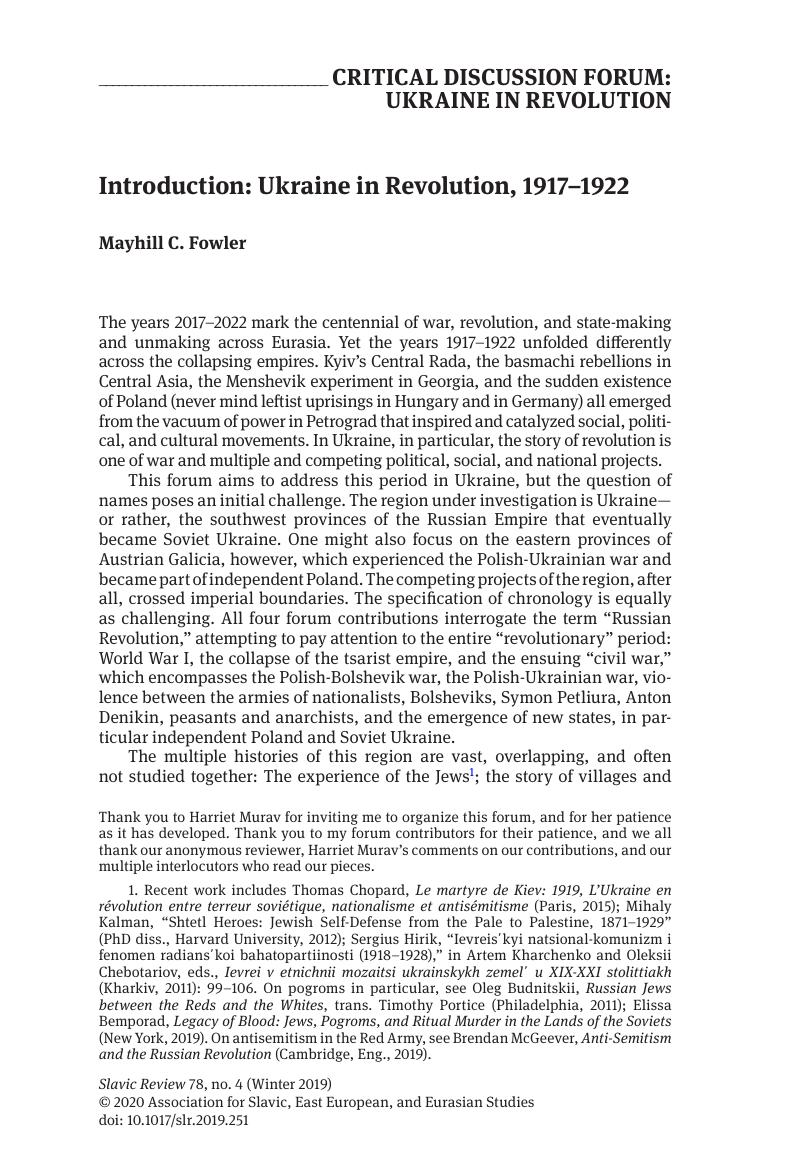No CrossRef data available.
Article contents
Introduction: Ukraine in Revolution, 1917–1922
Published online by Cambridge University Press: 27 January 2020
Abstract

- Type
- Critical Discussion Forum: Ukraine in Revolution
- Information
- Copyright
- Copyright © Association for Slavic, East European, and Eurasian Studies 2020
Footnotes
Thank you to Harriet Murav for inviting me to organize this forum, and for her patience as it has developed. Thank you to my forum contributors for their patience, and we all thank our anonymous reviewer, Harriet Murav's comments on our contributions, and our multiple interlocutors who read our pieces.
References
1 Recent work includes Chopard, Thomas, Le martyre de Kiev: 1919, L’Ukraine en révolution entre terreur soviétique, nationalisme et antisémitisme (Paris, 2015)Google Scholar; Mihaly Kalman, “Shtetl Heroes: Jewish Self-Defense from the Pale to Palestine, 1871–1929” (PhD diss., Harvard University, 2012); Hirik, Sergius, “Ievreis΄kyi natsional-komunizm i fenomen radians΄koi bahatopartiinosti (1918–1928),” in Kharchenko, Artem and Chebotariov, Oleksii, eds., Ievrei v etnichnii mozaitsi ukrainskykh zemel΄ u XIX-XXI stolittiakh (Kharkiv, 2011): 99–106Google Scholar. On pogroms in particular, see Budnitskii, Oleg, Russian Jews between the Reds and the Whites, trans. Portice, Timothy (Philadelphia, 2011)Google Scholar; Bemporad, Elissa, Legacy of Blood: Jews, Pogroms, and Ritual Murder in the Lands of the Soviets (New York, 2019)Google Scholar. On antisemitism in the Red Army, see McGeever, Brendan, Anti-Semitism and the Russian Revolution (Cambridge, Eng., 2019)Google Scholar.
2 Tolkatsch, Dimitri, “Lokale Ordnungsentwurfe am Ubergang vom Russischen Reich zur Sowjetmacht: Bauernaufstande und Dorfrepubliken in der Ukraine, 1917–1921” in Buchen, Tim and Grelka, Frank, eds., Akteure der Neuordnung. Ostmitteleuropa und das Erbe der Imperien, 1917–1924 (Berlin, 2017), 93–111Google Scholar.
3 On Ukrainian nationalism, see Gilley, Christopher, “Beyond Petliura: the Ukrainian National Movement and the 1919 Pogroms,” East European Jewish Affairs 47, no. 1 (2017): 45–61CrossRefGoogle Scholar, and “Untangling the Ukrainian Revolution,” Studies in Ethnicity and Nationalism 17, no. 3 (2017): 326–38CrossRefGoogle Scholar; on anarchists, Misha Akulov, “War without Fronts: Atamans and Commissars in Ukraine, 1917–1919” (PhD diss., Harvard University, 2013); on the failed Western Ukrainian National Republic, Pavlyshyn, Oleh, “Suspil΄no-politychna kryza v ZUNR u pershii polovyni 1919 r,” in Pavylyshyn, Oleh, ed., Ukraina: kul΄turna spadshchyna, national΄na svidomist,΄ derzhavnist΄ (L΄viv, 2009), 119–30Google Scholar.
4 See Portnova, Tetiana, “Misto i revoliutsiia: Katerynoslav 1917–1919 rr. v ukrains΄kykh memuarakh,” Moloda natsiia: Almanakh 32, no. 3 (2004): 52–62Google Scholar; Penter, Tanja, Odessa 1917: Revolution an der Peripherie (Cologne, 2000)Google Scholar.
5 Recent work on the war in Galicia is particularly rich; see, on gender, Baidak, Mar΄iana, “Prostory zhinochoho povsiadennia v roky Pershoi svitovoi viiny (na prykladi Halychyny i u svitli osobovykh zherel),” Istorychni ta kul΄turolohichni studii, vyp. 6–7 (2014–2015): 118–33Google Scholar; on disability, Oksana Vynnyk, “Postwar ‘Normalization’: The Reintegration of Disabled Veterans to Civilian Life in Interwar Lviv” (PhD diss., University of Alberta, 2018); on theater, Dudko, Oksana, “Mizh natsiona΄lnoiu i populiarnoiu kul΄turoiu: teatry v okupovanomu L΄vovi (veresen΄ 1914 roku-cherven΄ 1915 roku), Ukraina Moderna 23 (2016): 45–76Google Scholar.
6 Chernev, Borislav, Twilight of Empire: The Brest-Litovsk Conference and the Re-making of East-Central Europe (Toronto, 2018)Google Scholar; Boehler, Jochen, Civil War in Central Europe, 1918–1921: The Reconstruction of Poland (Oxford, 2018)CrossRefGoogle Scholar.
7 On gender more generally, see Kis΄, Oksana, “(Re)constructing Ukrainian Women’s History: Actors, Agents, and Narratives,” in Hankivsky, Olena and Salnykova, Anastasiya, eds., Gender, Politics, and Society in Ukraine (Toronto, 2012), 152–79Google Scholar; on gender and Ukrainian nationalism during World War II, see Havryshko, Marta, Dolaiuchy tyshu: Zhinochi istorii viiny (Kharkiv 2018)Google Scholar. After Marta Havryshko’s book, her work in English: and “Love and Sex in Wartime: Controlling Women’s Sexuality in the Ukrainian Nationalist Underground,” Aspasia 12, no. 1 (2018): 35–67Google Scholar.
8 On the Holocaust, see, for example, McBride, Jared, “Peasants into Perpetrators: The OUN-UPA and Ethnic Cleansing of Volhynia, 1943–1944,” Slavic Review 75, no. 3 (Fall 2016): 630–55CrossRefGoogle Scholar; Radchenko, Yuri, “Accomplices to Extermination: Municipal Government and the Holocaust in Kharkiv, 1941–1942,” Holocaust and Genocide Studies 27, no. 3 (2013): 443–63CrossRefGoogle Scholar; and Bartov, Omer, Anatomy of a Genocide: The Life and Death of a Town Called Buczacz (New York, 2018)Google Scholar.
9 See the MAPA project at the Harvard Ukrainian Research Institute, at https://www.huri.harvard.edu/mapa.html (accessed October 2, 2019); see also, for example, Daria Mattingly, “Idle, Drunk and Good-for-Nothing: The Rank and File Perpetrators of 1932–1933 Famine in Ukraine and their Representation in Cultural Memory,” (PhD diss., University of Cambridge, 2019).
10 For nuanced work on the current conflict, see, for example, Shukan, Ioulia, Generation Maidan: Vivre la crise ukrainienne (Paris, 2016)Google Scholar, and Lebedev, Anna Colin and Shukan, Iouila, eds., “S’engager dans la guerre du Donbass (2014-2018): Trajectoires individuelles et reconfigurations sociales,” special issue of Revue d’études comparatives Est-Ouest 49, no. 2 (2018)Google Scholar.
11 For example, see, Snyder’s, TimothyThe Reconstruction of Nations: Poland, Ukraine, Lithuania, Belarus, 1569–1999 (New Haven, 2003)Google Scholar, and opinion pieces at http://timothysnyder.org/ukraine (accessed October 2, 2019); Plokhy, Serhii, The Gates of Europe: A History of Ukraine (New York, 2017)Google Scholar; Mark Von Hagen, “1917: The Empire’s Diverging Revolutions,” The Russia File: A Blog of the Kennan Institute, November 7, 2017, at https://www.wilsoncenter.org/blog-post/1917-the-empires-diverging-revolutions (accessed October 2, 2019).
12 For an excellent comparison, however, see Tanya Zhurzhenko, “The Making and Unmaking of Revolutions: What 1917 Means for Ukraine in Light of Maidan,” Eurozine, November 30, 2017 at https://www.eurozine.com/the-making-and-unmaking-of-revolutions/ (last accessed October 2, 2019).




